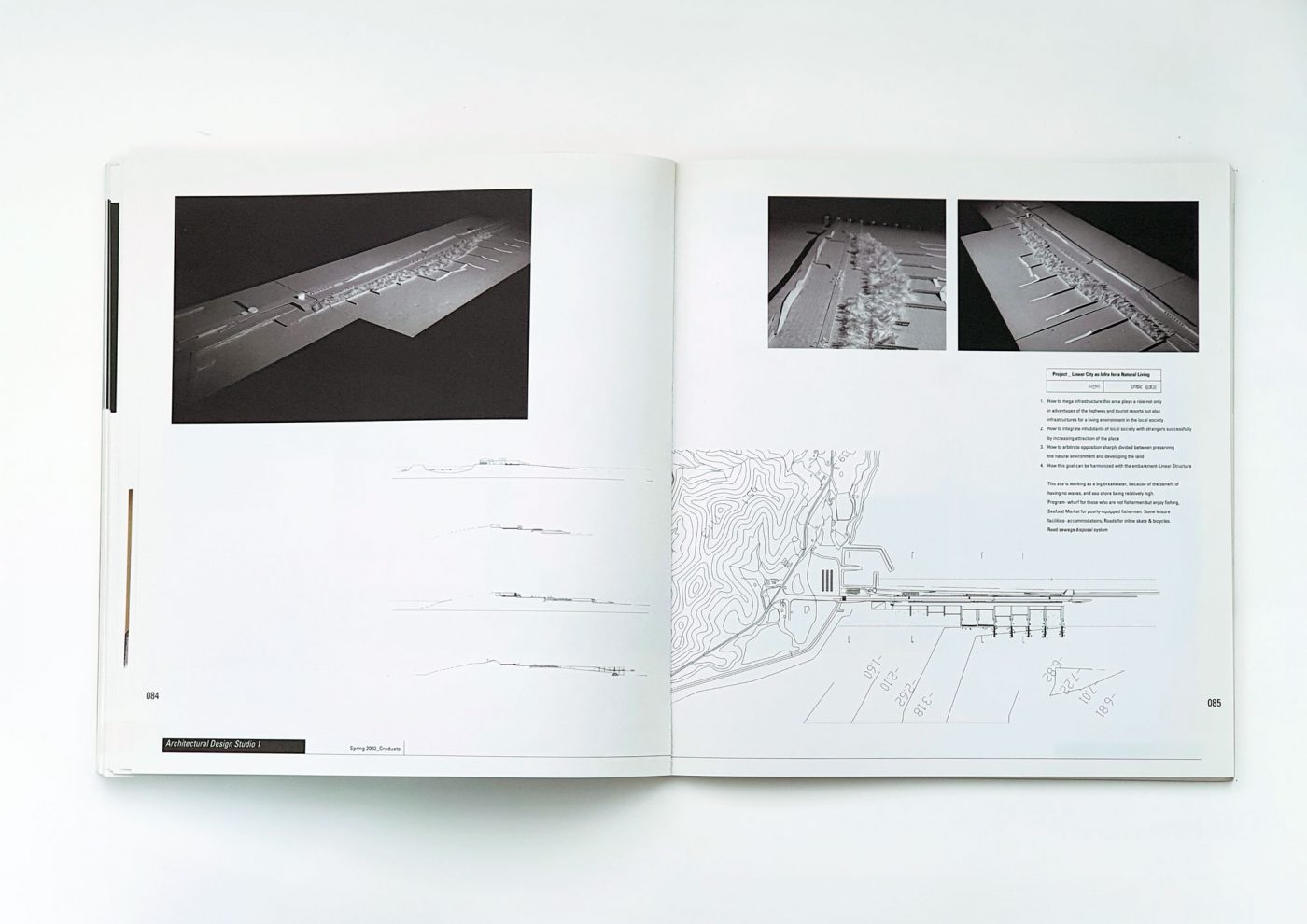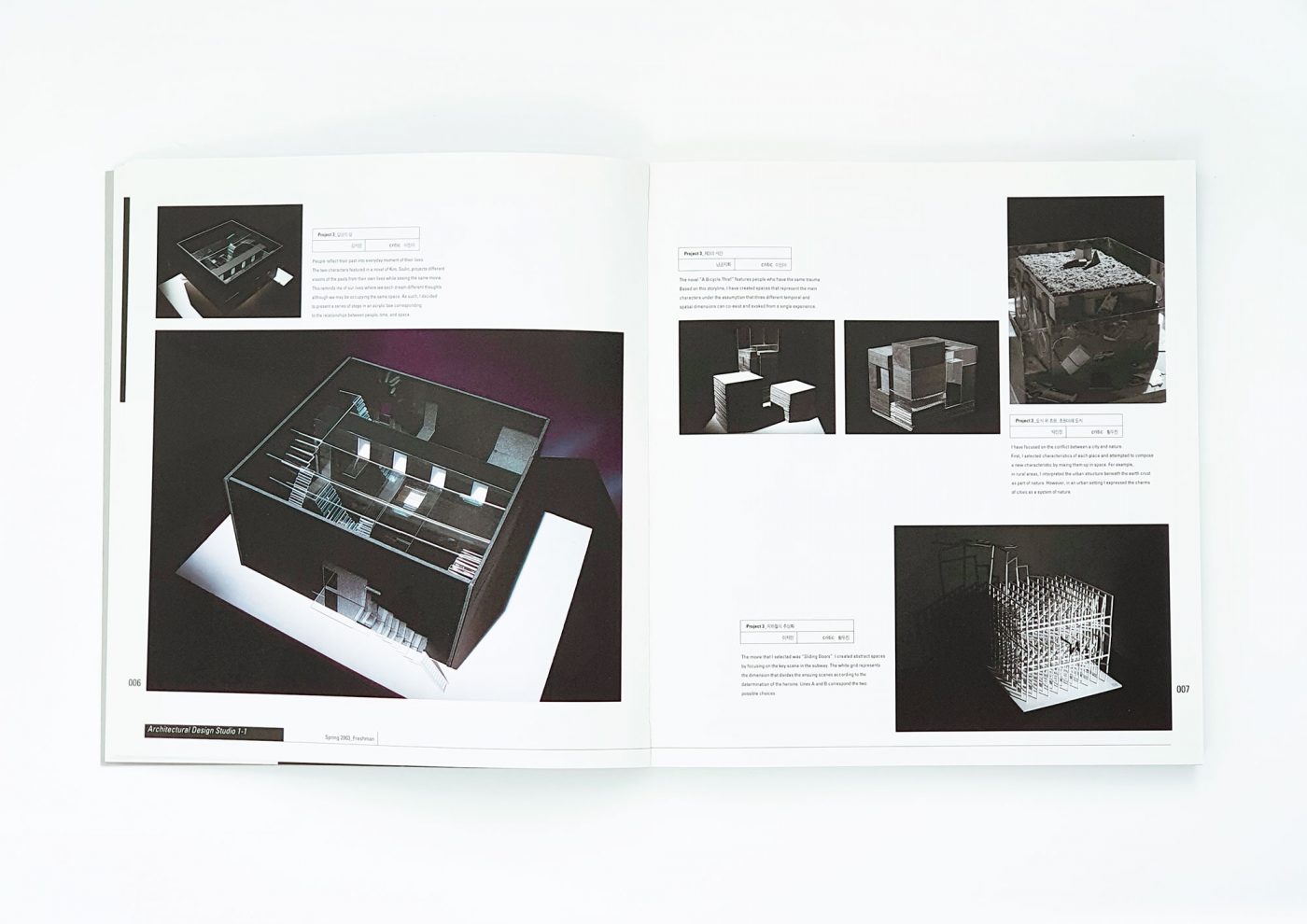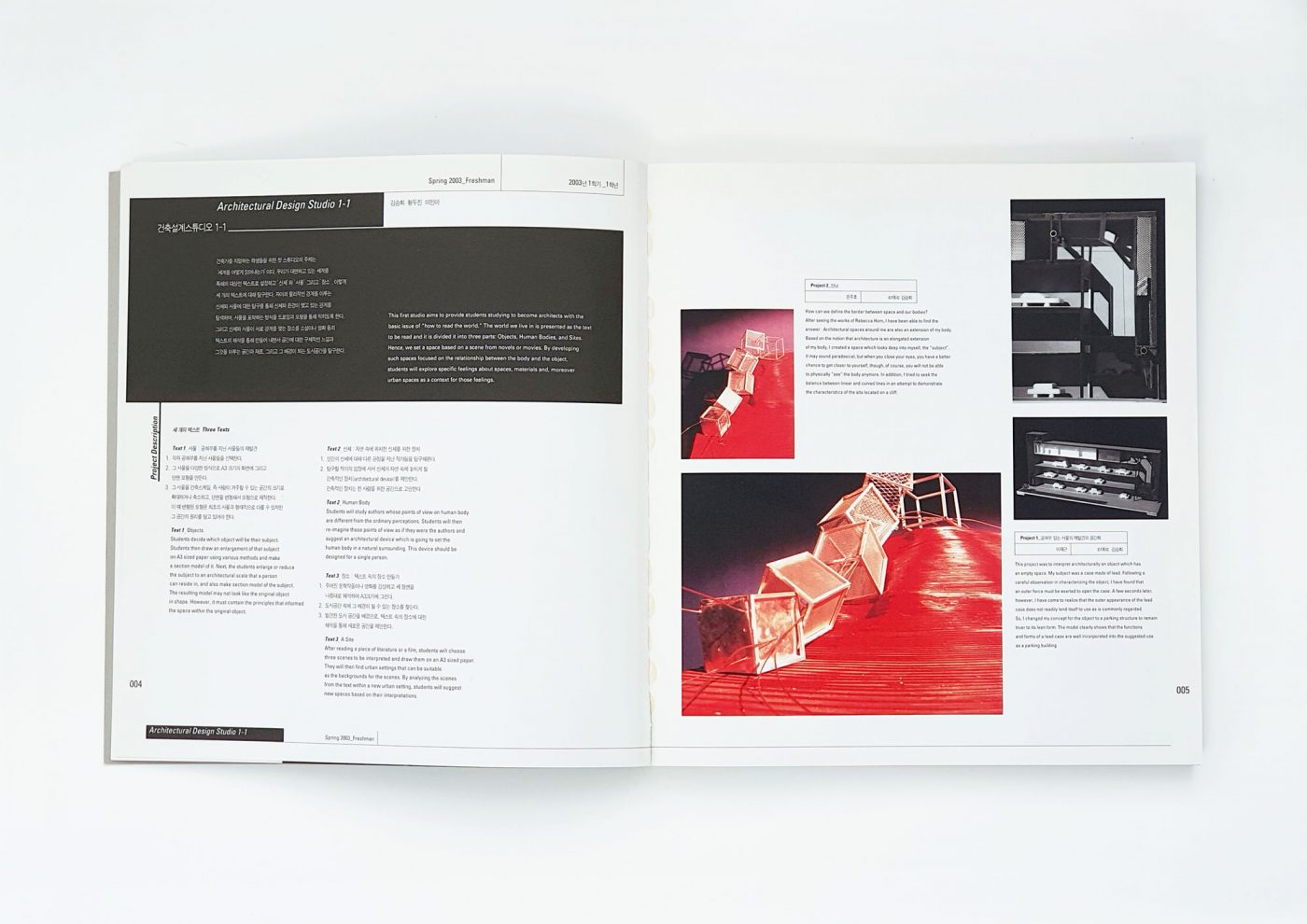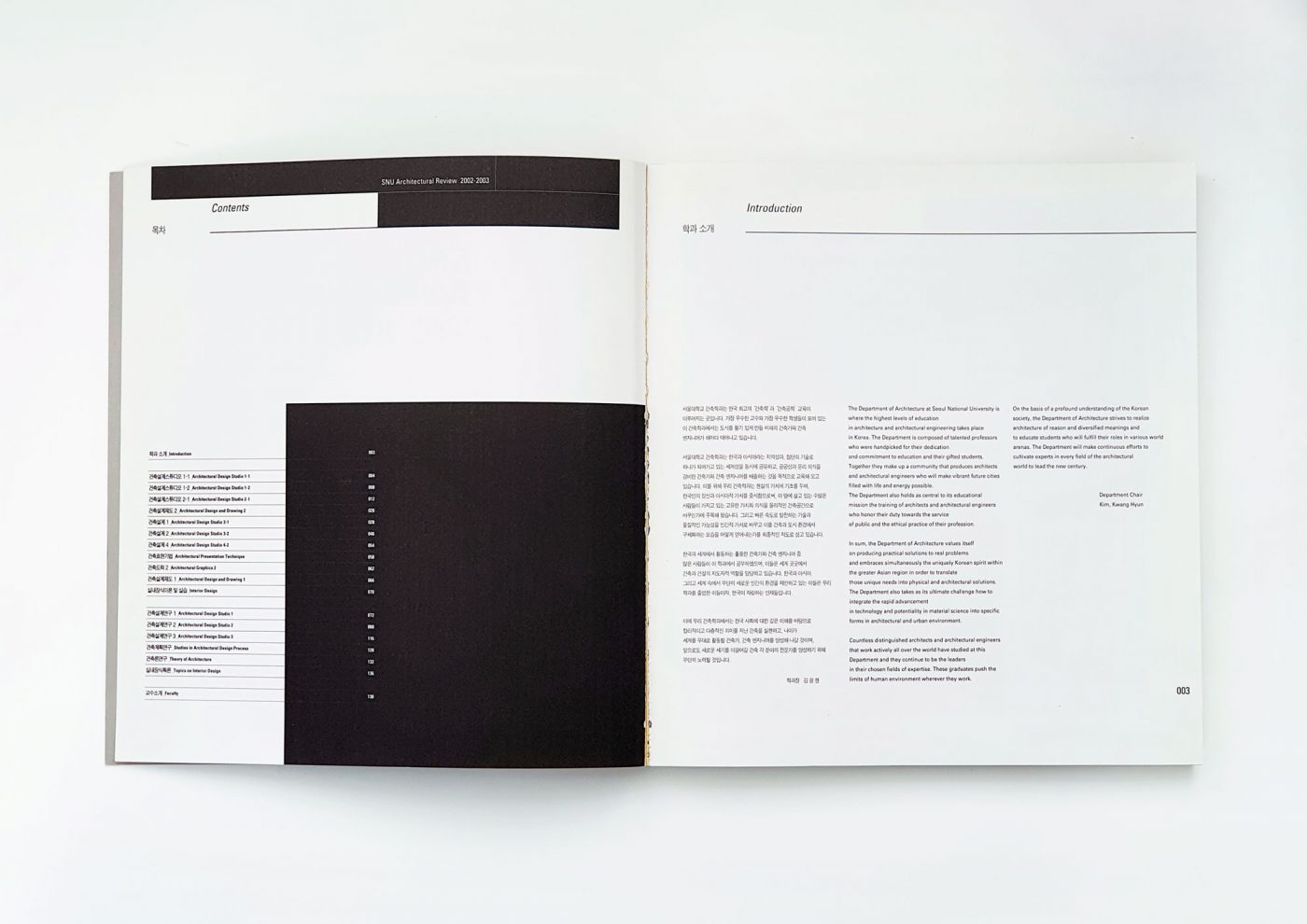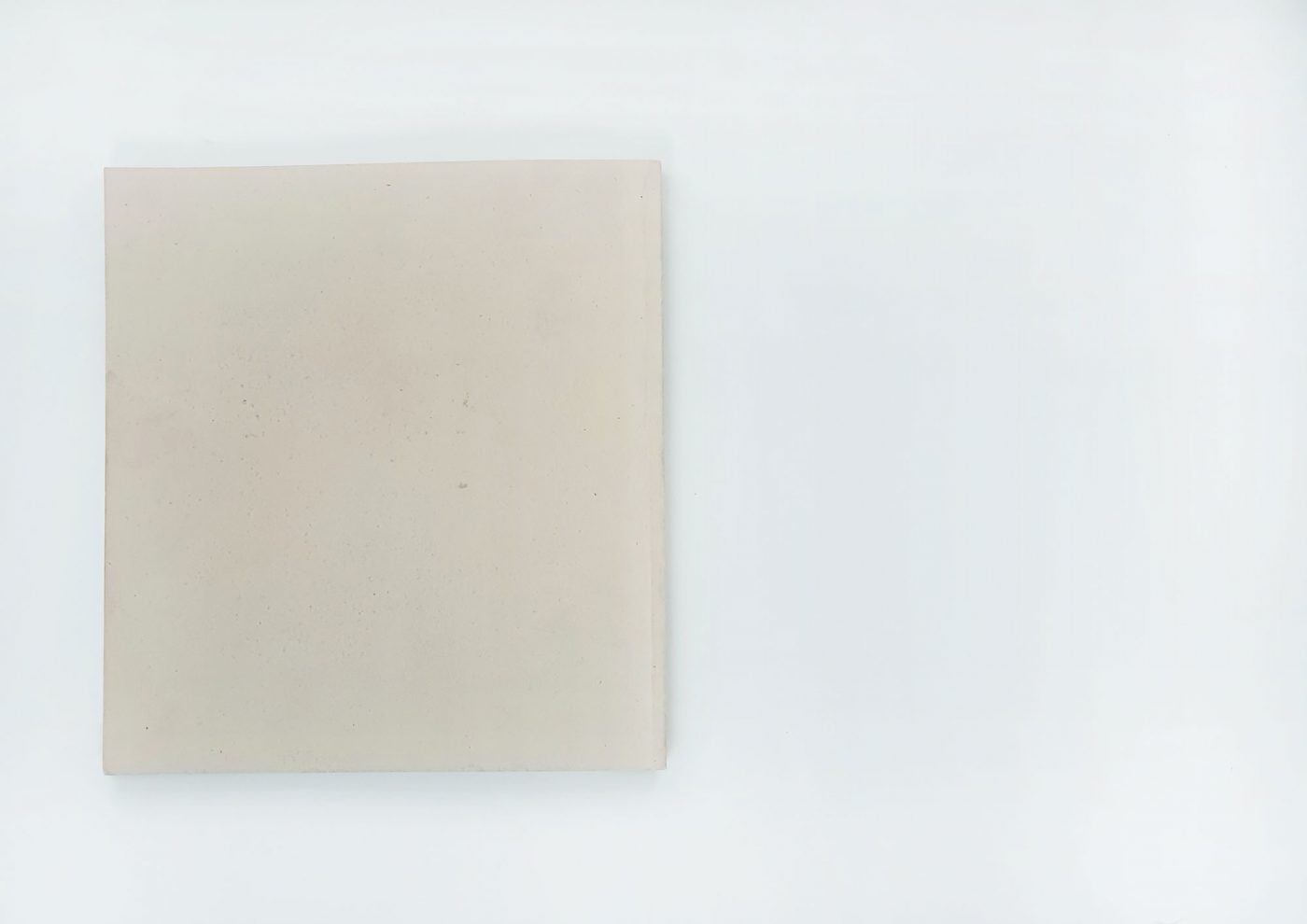SNU Architectural Review
2002 – 2003
2003, 1-1
건축설계스튜디오 1-1
세계를 어떻게 읽어내는가 :
신체, 사물, 장소
김승회, 황두진, 이민아
문주호, 이재근, 김시양, 남궁지희, 박민정, 이지민
건축가를 지망하는 학생들을 위한 첫 스튜디오의 주제는 '세계를 어떻게 읽어내는가' 이다. 우리가 대면하고 있는 세계를 독해의 대상인 텍스트로 설정하고 '신체'와 '사물' 그리고 '장소'. 이렇게 세 개의 텍스트에 대해 탐구한다. 자아의 물리적인 경계를 이루는 신체와 사물에 대한 탐구를 통해 신체와 환경이 맺고 있는 관계를 탐색하며, 사물을 포착하는 방식을 드로잉과 모형을 통해 익히도록 한다. 그리고 신체와 사물이 서로 관계를 맺는 장소를 소설이나 영화 등의 텍스트의 해석을 통해 만들어 내면서 공간에 대한 구체적인 느낌과 그것을 이루는 공간과 재료, 그리고 그 배경이 되는 도시공간을 탐구한다.
This first studio aims to provide students studying to become architects with the basic issue of "how to read the world." The world we live in is presented as the text to be read and it is divided it into three parts: Objects, Human Bodies, and Sites. Hence, we set a space based on a scene from novels or movies. By developing such spaces focused on the relationship between the body and the object, students will explore specific feelings about spaces, materials and, moreover urban spaces as a cotext for those feelings.
2003, 1-2
건축설계스튜디오 1-2
질서를 규정하기
최두남, 박헬렌, 남수현
곽서연, 서원기, 김태훈, 김인호, 김지하, 김광민
건축에서 공간을 만들어 나가는 과정의 주된 작업 중의 하나는 질서를 부여하는 일이다. 질서를 규정함에 있어 질서라 함은 개체와 개체간에, 개체와 전체간에 일정한 관계를 유지하도록 설정하는 작업을 뜻한다. 건축에서 질서라 함은 상기 언급한 관계의 설정은 물론 그 이상의 의미를 내포하고 있어야 한다. 이 스튜디오에서는 건축설계에 있어 보여지는 대상을 면밀히 관찰함으로써 현상이나 사물에 내재한 질서를 파악하도록 한다. 학생들은 구체적으로 나타나 있는 일상적인 사물을 추상화하는 과정을 통하여 그 특성을 연구한다. 이러한 훈련을 통하여 얻어진 사고를 취합하여 주어진 설계대상에 적용하도록 한다. 이 과정을 통하여 사물에 내재한 질서와 구체적으로 표현되어 지는 구조와 재료 및 공간의 기본적인 상관관계를 연구한다.
Order is one of the main tasks in creating space. Order is defined as establishment of relationship between an object and another object, or an object and the whole. Specific relationship among objects and phenomena can be set up by order. Order in architecture means the establishment of relationship mentioned above and beyond. The objective of this studio is to understand order in objects or phenomena through close observation of objects. Students study characteristics by abstracting the ordinary objects with concrete form. Thought obtained in this training is to be collectively applied to design subject. In this course, we will study the fundamental interrelation between the intrinsic order in objects and the explicitly-presented features such as structure, material, and space.
2003, 2-1
건축설계스튜디오 2-1
How to handle space
최두남, 박헬렌, 남수현
양희진, 김태훈, 김도윤, 서원기, 김지하, 양완석, 김한중, 조경민, 강순필 김인호 이준형 곽서연 김민진 신요한
이 과목은 건축적 사고와 설계를 통하여 건축적인 건축의 중심적인 관심사인 공간을 다루는 방법을 익히는 것이 목적이다. 설계교육의 궁극적 목적은 사회적, 환경적, 기술적, 미적고려를 종합하여 일관되고 통일된 건축적 실체를 이끌어 낼 수 있는 능력계발이라 할 수 있다. 좋은 설계가 이루어지기 위하여는 설계과정에 대한 이해가 필수적이며 설계 개념을 성공적으로 실현하려면 재료의 특성과 성능에 관한 지식을 가지고, 시공방법과 더불어 구조의 원리를 이해하며 상세설계를 통하여 설계의도를 실현시킬 수 있는 능력이 요구된다. 건축설계의 첫 입문이 되는 본 스튜디오에서는 공간을 설계함에 있어 환경, 사용자, 공간에 대한 학습 및 기술 숙달에 대한 비중을 높이며 또한 재료의 성질 및 시공과 구조시스템에 대하여 개론적으로 이해를 바탕으로 단순한 건물의 분석과 설계 및 의사전달에 대하여 최소한으로 숙달됨을 목표로 한다. 이와 병행되어야 할 사항으로 자료분석과 프로그래밍, 대지분석 등이 꼽힌다.
The objective of this studio is to learn through architectural thinking and design how to handle space, which is a major issue in architecture. The ultimate goal of architectural discipline is to develop capacity to extract architectural substance with consistency and unity based on social, environmental, technical, and aesthetic consideration. For better design it is necessary to have a clear understanding of the design process itself. For a successful realization of architectural concept, one must understand structural principles along with construction methad and be capable of carrying out the design intention through detail design, based on the knowledge of characteristic and analysis of materials.
2002, 2-2
건축설계제도 2
도시 속의 건축, 건축 속의 도시
김승회, 최재필, 권문성, 황두진
이지연, 송수경, 김성욱, 이고은, 박성우, 최영준, 황종호
도시 속의 건축, 건축 속의 도시: 집을 설계하는 것은 하나의 대지 위에 공간과 형태를 구현하는 일로 그치는 것이 아니라, 그것을 둘러싼 마을과 도시, 그리고 그것을 있게 한 여러 시스템들과 관계 맺는 것을 의미한다. 작은 대지에 집을 짓는다고 하더라도 건축가에게는 그것이 위치한 도시 전체가 그의 대지가 될 수 있다. 건축이 도시 속에 위치하는 것은 분명하지만, 도시를 대지로 인식하는 건축가에게는 도시가 그의 건축에 있기도 한 것이다. 이러한 인식을 바탕으로 도시 속의 건축, 건축 속의 도시에 대해 탐구하는 것이 과제의 목표이다. 그것은 '인사동'이라는 공간적 범위 안에서 도시가 갖고 있는 여러 양상들에 대한 관찰과 해석, 그리고 인사동에 대한 독해를 바탕으로 한 구체적인 설계를 통해 탐색될 것이다.
Architecture in the City; The City in Architecture_We define architecture as relations between a city and its systems, not as design a house in the assigned site. In this course, students will explore how many characteristics are exposed in a city and reflect their findings to their design. The site is Insa-dong where traditional texture and features still remain. Based on their findings, observations, and interpretations about Insa-dong, students will develop their designs within the site.
2003, 3-1
건축설계 1
프로그램의 해석
심우갑, 김현철, 이형욱, 임재용
방석환, 조현제, 김지홍, 김진휴, 이고은, 권재현, 황종호, 류주현, 박수정, 박성우, 김충은, 김하나, 박래훈
프로그램의 해석: 인간의 행위와 시설은 그 시대와 사용자에 의한 독특한 프로그램의 해석과 관련이 있다. 특히 근대 이후에 이루어진 건축물의 프로그램을 재해석하는 작업을 수행한다. 이를 위해 인간의 행위의 인접과 분리, 다른 요소의 개입을 통해 서로 다른 기능을 가진 용도를 결합하여 더 큰전체를 완성해가는 설계방식을 탐구한다. 이에는 면적과 기능관계를 실제의 법규의 제약조건을 따르면서, 동시에 이 공공건물을 이용하는 사람들의 공동체 의식을 고양하기 위한 지역의 인문적 조건에 주목하면서 소규모의 공공 공간을 제작한다. 후반부에서는 학교나 도서관과 같은 공공시설이 제도적인 측면에서 근대 이후 어떻게 해석되어 왔으며, 공간의 배열은 제도를 포함한다는 전제에서 시설 또는 제도에 대한 비판을 통해 새로운 시대에 적합한 공간의 배열을 가진 건축을 생각한다.
Interpretation of Program Human activities and facilities that contain them are related to interpretation of unique programs by time and user of those facilities. We will explore buildings constructed after the modern age, in particular, and re-interpretate their programs. We will focus on the context of the site and the method to promote the sense of community as limited by the relevant laws and functional demands. In the latter part of the course, we will discuss how public facilities such as libraries and schools have changed and interpreted with the assumption that spatial arrangements represent interpretation of facilities that make up an institution.
2003, 3-2
건축설계 2
Human behaviors and space
심우갑, 김현철, 이형욱, 임재용
박무찬, 정승수, 성나영, 이상흠, 임동우, 김하나, 김민철
이 단계에서는 개별적인 행위의 집합인 집단 행위에 대응하는 공간의 구성을 연습한다. 각 개인은 제각기 의지를 가지고 공간 속에서 행위를 연속시키는 것이다. 집주하는 행위, 행위에 대한 명확하지 못한 공간적, 시각적인 경계, 공간의 유동화처럼 공간의 개념을 순수하게 인간 행위의 분포에 주목함으로써, 다양한 사건과 행위가 동기에 있는 것을 혀용하고 이것이 만들어내는 공간을 설계한다. 이에 따라 외부와 내부의 경계, 연속성, 가구, 공간의 불균질성, 건축 속의 빈 장소, 시간, 공존하는 공간, 사람의 집합이 만들어내는 장면 등, 다양한 건축적 도시적 공간의 구성을 습득한다.
Human Behaviors and Space_This studio's main purpose is to have student experiment and practice composing and organizing spaces that react to group behavior which is made up of behaviors of individuals. Individuals continually move through space according to his or her independent will. In designing spaces, students learn to focus on distribution of various forms of human behaviors in their pure state they move flow over the borders between spatial and temporal lines which allow such events and behaviors to have motives of their own in a given space. As a result, student acquire the ability to design different and urban architectural spaces such as the borderline between interior and exterior, spaces that embrace the continuity, void, and ones that engenders coming together of people etc. The projects are Performing Arts Center and Office Buildings.
2002, 4-2
건축설계 4
an emphasis on urban planning
and design
김진균, 최재필
이주호, 김기환, 최정석, 이효석
건축과 도시, 기술과 환경에 대한 자신의 해석을 바탕으로 한 독립적이며 설계를 통해 건축가로서 가져야 할 종합적이며 실천적인 작품을 제작한다. 따라서 이 단계에서는 수강자 개인이 독자적으로 설정할 주제를 구체화 한다. 건축설계의 마지막 학기로서, 졸업설계 이후 그간 닦은 개인의 역량을 발휘하여 매번 특정한 프로젝트를 대상으로 한다. 다루는 프로젝트는 다음의 범주를 포함한다 ; 복잡한 건물의 설계 ; 도시설계, 도시계획을 강조한 프로젝트 데이터수집, 분석, 프로그래밍, 계획및 설계 ; 구조, 빌딩시스템, 조경설계, 기타 관련지식에의 숙달.
This is the last studio in the (old) 4-year curriculum toward the degree in architecture. Students have finished the graduation project in spring; this fall studio deals with a specific project with the following goals: Design of complex buildings with an emphasis on urban planning and design; Incorporation of data collection, data analysis, programming, planning and design; consideration and design of building structure, building system, landscape architecture and other inherent problems.
2002, 1-1
건축표현기법
Visual Essay
최두남, 전봉희
김신혜, 장지을, 김정식, 박민정, 박요한, 한대곤, 이진식, 양지수, 김충은, 문주호, 권도엽
이 과목은 건축표현기법 및 시각적 탐구를 통하여 공간 구성에 대한 기본 개념을 익히고 과제를 통하여 건축과 연관된 주제들을 다루고자 한다. 학생들은 Visual Essay로 종결되는 과제들을 수행하면서 다양한 방법으로 건축적 주제들을 표현하도록 요구된다. 건축에 있어서 그린다는 것은 창조의 수단일뿐 아니라 의사소통의 수단이다. 표현기법은 표현하고자 하는 개념과 대상에 대한 본질적인 분석과 이해를 바탕으로 적확한 수단으로 자유로이 의사소통하는 능력을 키우는 것을 목표로 한다.
The objective of this course is to understand fundamental concept of framework of space through architectural presentation and casual study, and deal vwith subjects related to architecture through exercises. Through a series of assignment that concludes with Visual Essay, students are to present the architectural subjects in various ways. Drawing in architecture is not only a creation method but also a communication tool. In this course, we aim for fluency in communication based on the fundamental analysis and understanding of an idea and objects to be presented.
2002, 1, 2-2
건축도학 2
요소 파악, 건축적 사고, 제도 연습, 기초적 설계
전봉희
최순호, 김일희, 김영민, 김하나
수업 목표는 다음 네 가지이다. 즉, 건축의 기본적인 요소를 파악하고 관찰과 감상을 통한 건축적 사고를 연습하며 건축 도면의 제도를 연습하고, 기초적 설계 과제를 수행하는 것이다.
This course aims to provide the next 4 goals: general understanding of architectural elements, analysis of existing buildings through keen observation and contemplation, practices in architectural representations, and design of fundamental elements.
2003, 2-1
건축설계제도 1
human behavior and human scale
여상진, 최동혁
김일희, 김초롱, 이황, 김영민, 김재동, 김정식
건축설계 입문 과정으로서 인간 행태의 탐구 및 휴먼 스케일의 체득을 바탕으로 대지 및 프로그램의 창조적 해석을 통한 설계안 도출 능력을 배양하는 것을 목적으로 한다. 이를 위하여 제한된 공간에 내부공간 구성 연습, 제시된 대지에 외부공간 구성 연습, 최종적으로 단독주택 설계라는 총 3개의 과제가 주어진다.
The first semester of the architectural design course introduces students to develop their designs within the selected site. Students' proposals need to be based on human behavior and human scale. The studio consists of three design projects. The first project focuses on interior space of the two cubes. The second one emphasizes on the conceptualization of the existing site conditions. The final project is to design a single-family house at the site that represents the overall city block.
2002, 4-2
실내장식 이론 및 실습
Interior design
김현철
김충호
실내장식 이론 및 실습 이 강의에서는 시각적인 측면에서만 다루었던 실내 설계를 넘어, 작은 규모에서 계획, 재료, 가구, 시공, 설비 등이 통합되는 과정을, 이를 위해 소규모 또는 중규모의 주택 또는 상업공간 내부를 설계하고, 이에 필요한 재료, 가구, 기계 및 전기설비가 어떻게 통합되어야 하는가를 습득한다. 나아가 규모의 커뮤니티 시설 또는 공공 건물의 실내를 계획하고 이에 대응하는 재료, 마감 등 각종 실무적 문제를 습득한다.
In this course, students study interior design in terms of material, furniture, construction, and facilities in integrating manner. Students are asked to design a house with detailed consideration in materials, furniture, and electric facilities. Students then design bigger projects such as community facilities and public buildings with inherent site problems.
2003, 대학원 1학기
건축설계연구 1
경계
김승회, 승효상
유영수, 우준승, 김세진, 김병준, 윤정원, 이승우, 이선미, 오진국
건축은 근본적으로 세계와의 경계이며 관계이다. 또한 건축은 세계와 화해하고, 대결하는 방식을 스스로 드러내는 장치이다. 건축이 하나의 공간, 하나의 필지, 하나의 경계를 넘어서는 집합적인 방식이라는 것을 인정한다면, 그리고 건축이 나와 너의 건축임을 넘어서, 우리와 그들의 건축임을 인정한다면, 우리의 관심은 건축과 도시가 만나는 경계와 영역, 그리고 도시와 도시의 '영역' 과 그들이 만나는 '경계' 에 대한 관심으로 펼쳐지게 된다. 도시 속의 도시들 그리고 그 관계들이 만들어 내는 파노라마를 탐색하는 것이 스튜디오의 과제이다. '도시 속의 도시' 들의 경계면 위로 드러나는 내밀한 관계들 속에서 도시의 시간과 공간은 어떻게 경계가 지워지고 그 속의 건축은 어떤 방식으로 존재하는지, 그 지층들을 읽어보는 일은 우리의 삶과 건축의 조건들을 살피는 기회가 될 것이다. 발견된 진실과 허구 속에서 제안하는 도시와 건축의 기획들은 우리 삶의 조건에 진지한 질문을 던질 수 있을 것이다.
We define architecture as a mechanism that expresses confrontations between borders, which means architecture cannot be confined just in a private territory, but in a public one. Therefore, architecture should be the common interest. This studio is aimed at researching the relationship between areas and borders, which meas how the spaces in the city are divided and related. By analyzing our lives thoroughly, students will pose questions of what should be the conditions of our lives in the city.
2002, 대학원 2학기
건축설계연구 2
전통으로부터 배운다
최두남, 승효상
김훈, 고대영, 남지현, 송준엽, 장필구, 홍종철, 우준승, 김주일, 배우영, 김명숙, 허세연, 맹필수, 윤정원, 최순용, 오진국
도시의 역사성과 장소성 및 공간조직에 대한 이해를 바탕으로 우리 건축의 현대적 해석과 그 적용 가능성에 대해 연구하는 것을 주 테마로 한다. 이를 위해 전통 도시주거지에 대한 현지답사를 통해 공간구성의 특성과 맥락을 분석하고, 여기서 추출한 우리건축의 다양한 설계방법과 건축어휘 및 공간의 현대적 해석을 도시주거, 공공시설, 문화시설 등의 설계에 반영하는 과제를 수행한다.
Based on understandings in history, context, and texture of a city, students will contemplate on the modern interpretation and applications of traditional Korean architecture. Students are asked to visit traditional city housing and analyze its spatial aspects and context. From the detection of skills and principles used in architecture at that time, students would apply their findings to their design projects such as modern housing, public, and cultural facilities.
2003, 대학원 1학기
건축설계연구3
large scale building
최두남, 김현철
박연정, 최정석, 신예경, 허세연, 백선영, 차재용
계획과 설계과정에 있어서 보다 전문적이고 세부적인 지식과 연구를 요하는 건축물을 다룬다. 본 과목의 운영은 설계주제의 특수성에 따라 담당교수와 상의하여 개별적으로 선택, 과제를 수행해 나간다.
A design project will be undertaken for a large scale building. The program, site, and bid documents for a recently completed local project will provide the basis for three phase of work; research(2 weeks), design(4 weeks), and development(6 weeks). Each phase will associate technological, programmatic, and compositional considerations.
2003, 대학원 1학기
건축계획연구
총체적 건축계획에 대한 전문적 연구
김현철
이효석, 홍종철
건축설계의 기반을 이루는 총체적 건축계획에 대한 전문적 연구를 목표로 한다. 이론계획학의 한계에 머물지 않고 건축가들이 설계할 때 실제로 부딪쳐 온 작품구성의도, 작업전략, 공간 및 형태구성 방식을 광범위하게 분석함으로써 건축작품에 대한 이해를 넓힘과 동시에 그 결과를 자기 건축에 도입함으로써 독창적인 건축언어를 수립할 수 있는 기초와 근거를 연구한다.
This course aims to study professionally on comprehensive planning of architecture which forms the foundation of architectural planning, to broaden the width of understanding of architectural works through analyzing the ways of forming space and its shape beyond the limit of theoretical planning, and at the same time studies the groundwork to set up students' own creative language of architecture by introducing the studied results into students' works.
2002, 대학원2학기
건축론연구
어떤 논리로 집을 지어가야 하는가
김광현
이정민, 김주일, 오진국, 윤정원, 배우영, 이강민, 유영수, 고애양
건축이 발생하며 인간과 사회를 위해 구체적인 형태와 공간을 갖추는 근거가 무엇인지를 생각한다. 특히 근대 미 현대에서 이루어졌던 건축이 만들어지는 근거와 건축을 만드는 구체적인 방법을 고찰하고, 이것이 도시 안에서 프로그램과 구조, 풍경과 장소라는 모습으로 구현되는 건축가의 논리를 분석한다. 그 결과 건축가가 어떤 논리로 집을 짓는가 하는 이론 자체에 대한 연구보다는 건축가가 어떤 논리로 집을 지어가야만 하는가 하는 건축가 스스로의 이론화의 문제를 더욱 중요하게 생각한다.
The primary object of this course is to consider how architecture originated and has developed its logic about form and space for human beings. Especially, we concentrated on the modern and contemporary architecture and then scrutinized on which base the architecture is developed and then analyzed the logic of architects in the form of structure, landscape, and place in relation to the city. As a result, we thought it more important to establish an architect's own principle-in what way an architect should develop his or her own design - than to research only on the theory and methodology itself.
2002, 대학원 2학기
실내장식특론
실내공간 구성언어와 구성방법
김현철
한지원
실내장식을 이론적, 실천적으로 깊이 있게 공부하는 과목으로서, 실내장식을 단순한 장식에서 벗어나 공간을 구축하고 표현하는 독자적 영역으로 정의한다. 실내공간 구성언어와 구성방법 및 그 이론적 뒷받침과 실제 사례를 동서양을 넘나들며 연구한 뒤 이에 비추어 자기 작품 경향을 스스로 분석하고 이를 자신의 고유한 실내공간 디자인 전략으로 가다듬는다.
As it is the course for studying interior design fundamentally, theoretically and practically, interior design is to be defined not as mere decoration but as an independent realm of constructing and expressing space. With the unobstructed study of the language and way of construction, its theoretical support and practical cases in Eastern and Western world, students will analyze inclination of their own works by themselves and set their own strategies of design of interior space.


